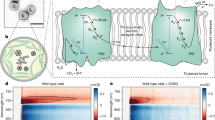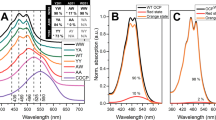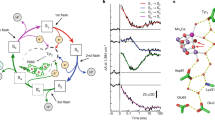Abstract
In water-oxidizing photosynthetic organisms, light absorption generates a powerfully oxidizing chlorophyll complex (P680•+) in the photosystem II reaction centre. This is reduced via an electron transfer pathway from the manganese-containing water-oxidizing catalyst, which includes an electron transfer relay comprising a tyrosine (Tyr)–histidine (His) pair that features a hydrogen bond between a phenol group and an imidazole group. By rapidly reducing P680•+, the relay is thought to mitigate recombination reactions, thereby ensuring a high quantum yield of water oxidation. Here, we show that an artificial reaction centre that features a benzimidazole–phenol model of the Tyr–His pair mimics both the short-internal hydrogen bond in photosystem II and, using electron paramagnetic resonance spectroscopy, the thermal relaxation that accompanies proton-coupled electron transfer. Although this artificial system is much less complex than the natural one, theory suggests that it captures the essential features that are important in the function of the relay.
This is a preview of subscription content, access via your institution
Access options
Subscribe to this journal
Receive 12 print issues and online access
$259.00 per year
only $21.58 per issue
Buy this article
- Purchase on Springer Link
- Instant access to full article PDF
Prices may be subject to local taxes which are calculated during checkout





Similar content being viewed by others
References
Babcock, G. T. et al. Water oxidation in photosystem II: from radical chemistry to multielectron chemistry. Biochemistry 28, 9557–9565 (1989).
Zouni, A. et al. Crystal structure of photosystem II from Synechococcus elongatus at 3.8 Å resolution. Nature 409, 739–743 (2000).
Umena, Y., Kawakami, K., Shen, J-R. & Kamiya, N. Crystal structure of oxygen-evolving photosystem II at a resolution of 1.9 Å. Nature 473, 55–60 (2011).
Barry, B. A. & Babcock, G. T. Tyrosine radicals are involved in the photosynthetic oxygen-evolving system. Proc. Natl Acad. Sci. USA 84, 7099–7103 (1987).
Mamedov, F., Sayre, R. T. & Styring, S. Involvement of histidine 190 on the D1 protein in electron/proton transfer reactions on the donor side of photosystem II. Biochemistry 37, 14245–14256 (1998).
Hays, A-M. A., Vassiliev, I. R., Golbeck, J. H. & Debus, R. J. Role of D1-His190 in proton-coupled electron transfer reactions in photosystem II: a chemical complementation study. Biochemistry 37, 11352–11365 (1998).
Meyer, T. J., Hang, M., Huynh, V. & Thorp, H. H. The role of proton coupled electron transfer (PCET) in water oxidation by photosystem II. Wiring for protons. Angew. Chem. Int. Ed. 46, 5284–5304 (2007).
Barry, B. A. Proton coupled electron transfer and redox active tyrosines in photosystem II. J. Photochem. Photobiol. B 104, 60–71 (2011).
Hammarstöm, L. & Styring, S. Proton-coupled electron transfer of tyrosines in photosystem II and model systems for artificial photosynthesis: the role of a redox-active link between catalyst and photosensitizer. Energy Environ. Sci. 4, 2379–2388 (2011).
Styring, S., Sjöholm, J. & Mamedov, F. Two tyrosines that changed the world: interfacing the oxidizing power of photochemistry to water splitting in photosystem II. Biochim. Biophys. Acta 1817, 7–87 (2012).
Faller, P. et al. Rapid formation of the stable tyrosyl radical in photosystem II. Proc. Natl Acad. Sci. USA 98, 14368–14373 (2001).
Rappaport, F. et al. Probing the coupling between proton and electron transfer in photosystem II core complexes containing a 3-fluorotyrosine. J. Am. Chem. Soc. 131, 4425–4433 (2009).
Stubbe, J. A. & van der Donk, W. A. Protein radicals in enzyme catalysis. Chem. Rev. 98, 705–762 (1998).
Faller, P., Rutherford, A. W. & Debus, R. J. Tyrosine D oxidation at cryogenic temperature in photosystem II. Biochemistry 41, 12914–12920 (2002).
Faller, P., Goussias, C., Rutherford, A. W. & Un, S. Resolving intermediates in biological proton-coupled electron transfer: a tyrosyl radical prior to proton movement. Proc. Natl Acad. Sci. USA 100, 8732–8735 (2003).
Gust, D., Moore, T. A. & Moore, A. L. Realizing artificial photosynthesis. Faraday Discuss. 155, 9–26 (2012).
Gust, D., Moore, T. A. & Moore, A. L. Molecular mimicry of photosynthetic energy and electron transfer. Acc. Chem. Res. 26, 198–205 (1993).
Megiatto, J. D. Jr et al. Mimicking the electron transfer chain in photosystem II with a molecular triad thermodynamically capable of water oxidation. Proc. Natl Acad. Sci. USA 109, 15578–15583 (2012).
Rajh T., Nedeljkovic J. M., Chen L. X., Poluektov O. & Thurnauer M. C. Improving optical and charge separation properties of nanocrystalline TiO2 by surface modification with vitamin C. J. Phys. Chem. B 103, 3515–3519 (1999).
Moore, G. F. et al. A bioinspired construct that mimics the proton coupled electron transfer between P680•+ and the TyrZ–His190 pair of photosystem II. J. Am. Chem. Soc. 130, 10466–10467 (2008).
Stone, A. J. g factors of aromatic free radicals. Mol. Phys. 6, 509–515 (1963).
Smirnova, T. I., Smirnov, A. I., Paschenko, S. V. & Poluektov, O. G. Geometry of hydrogen bonds formed by lipid bilayer nitroxide probes: a high-frequency pulsed ENDOR/EPR study. J. Am. Chem. Soc. 129, 3476–3477 (2007).
Orio, M. et al. Geometric and electronic structures of phenoxyl radicals hydrogen bonded to neutral and cationic partners. Chem. Eur. J. 18, 5416–5429 (2012).
Thomas, F. et al. How single and bifurcated hydrogen bonds influence proton-migration rate constants, redox, and electronic properties of phenoxyl radicals. Angew. Chem. Int. Ed. 43, 594–597 (2004).
Benisvy, L. et al. Phenoxyl radicals hydrogen-bonded to imidazolium: analogues of Tyrosyl D• of photosystem II: high-field EPR and DFT studies. Angew. Chem. Int. Ed. 44, 5314–5317 (2005).
Un, S., Atta, M., Fontecave, M. & Rutherford, A. W. g-Values as a probe of the local protein environment: high-field EPR of tyrosyl radicals in ribonucleotide reductase and photosystem II. J. Am. Chem. Soc. 117, 10713–10719 (1995).
Un, S., Gerez, C., Elleingand, E. & Fontecave, M. Sensitivity of tyrosyl radical g-values to changes in protein structure: a high-field EPR study of mutants of ribonucleotide reductase. J. Am. Chem. Soc. 123, 3048–3054 (2001).
Saito, K., Shen, J-R., Ishida, T. & Ishikita, H. Short hydrogen bond between redox-active tyrosine YZ and D1-His190 in the photosystem II crystal structure. Biochemistry 50, 9836–9844 (2011).
Sibert, R. et al. Proton-coupled electron transfer in a biomimetic peptide as a model of enzyme regulatory mechanisms. J. Am. Chem. Soc. 129, 4393–4400 (2007).
Markle, T. F., Rhile, I. J., Dipasquale, A. G. & Mayer, J. M. Probing concerted proton–electron transfer in phenol–imidazoles. Proc. Natl Acad. Sci. USA 105, 8185–8190 (2008).
Costentin, C., Robert, M. & Saveant, J-M. Electrochemical and homogeneous proton-coupled electron transfers: concerted pathways in the one-electron oxidation of a phenol coupled with an intramolecular amine-driven proton transfer. J. Am. Chem. Soc. 128, 4552–4553 (2006).
Fecenko, C. J., Thorp, H. H. & Meyer, T. J. The role of free energy change in coupled electron–proton transfer J. Am. Chem. Soc. 129, 15098–15099 (2007).
Hammes-Schiffer, S. Theory of proton-coupled electron transfer in energy conversion processes. Acc. Chem. Res. 42, 1881–1889 (2009).
Perrin, C. L. & Nielson, J. B. ‘Strong’ hydrogen bonds in chemistry and biology. Annu. Rev. Phys. Chem. 48, 511–544 (1997).
Megiatto, J. D. Jr et al. Intramolecular hydrogen bonding as a synthetic tool to induce chemical selectivity in acid catalyzed porphyrin synthesis. Chem. Commun. 48, 4558–4560 (2012).
Nurminen, E. J., Mattinen, J. K. & Lönnberg, H. Nucleophilic and acid catalysis in phosphoramidite alcoholysis. J. Chem. Soc. Perkin Trans. 2, 2159–2165 (2001).
Moore, G. F. et al. Effects of protonation state on a tyrosine–histidine bioinspired redox mediator. J. Phys. Chem. B 114, 14450–14457 (2010).
Edwards, J. S., Soudackov, A. V. & Hammes-Schiffer, S. Analysis of kinetic isotope effects for proton-coupled electron transfer reactions. J. Phys. Chem. A 113, 2117–2126 (2009).
Witwicki, M. & Jezierska, J. Protic and aprotic solvent effect on molecular properties and g-tensors of o-semiquinones with various aromacity and heteroatoms: a DFT study. Chem. Phys. Lett. 493, 364–370 (2010).
Witwicki, M., Jezierska, J. & Ozarowski, A. Solvent effect on EPR, molecular and electronic properties of semiquinone radical derived from 3,4-dihydroxybenzoic acid as model for humic acid transient radicals: high-field EPR and DFT studies. Chem. Phys. Lett. 473, 160–166 (2009).
Barry, B. A. et al. Proton-coupled electron transfer and redox active tyrosines: structure and function of tyrosyl radicals in ribonucleotide reductase and photosystem II. J. Phys. Chem. Lett. 3, 534–554 (2012).
Jenson D. L. & Barry, B. A. Proton-coupled electron transfer in photosystem II: proton inventory of a redox active tyrosine. J. Am. Chem. Soc. 131, 10567–10573 (2009).
Chatterjee, R. et al. High-frequency electron nuclear double-resonance spectroscopy studies of the mechanism of proton-coupled electron transfer at the tyrosine-D residue of photosystem II. Biochemistry 52, 4781–4790 (2013).
Zhao, Y. et al. Improving the efficiency of water splitting in dye-sensitized solar cells by using a biomimetic electron transfer mediator. Proc. Natl Acad. Sci. USA 109, 15612–15616 (2012).
Rajh, T., Ostafin, A. E., Micic, O. I., Tiede, D. M. & Thurnauer, M. C. Surface modification of small particle TiO2 colloids with cysteine for enhanced photochemical reduction: an EPR study J. Phys. Chem. 100, 4538–4545 (1996).
Lakshmi, K. V. et al. High-field EPR study of carotenoid and chlorophyll cation radicals in photosystem II. J. Phys. Chem. B 104, 10445–10448 (2000).
Acknowledgements
This work was supported as part of the Center for Bio-Inspired Solar Fuel Production, an Energy Frontier Research Center funded by the US Department of Energy, Office of Science, Office of Basic Energy Sciences (award DE-SC0001016). D.D.M.H. was supported by the National Science Foundation Graduate Research Fellowship Program (NSF-GRFP; grant no. DGE-0802261), by the More Graduate Education at Mountain States Alliance (MGE@MSA) and by the Alliance for Graduate Education and the Professoriate (AGEP), National Science Foundation Cooperative agreement no. HRD-0450137. The high-frequency EPR work was supported by the US Department of Energy, Office of Basic Energy Sciences, Division of Chemical Sciences, Geosciences, and Biosciences (contract no. DE-AC02-06CH11357, O.G.P.). The work performed at the Center for Nanoscale Materials was supported by the US Department of Energy, Office of Science, Office of Basic Energy Sciences (contract no. DE-AC02-06CH11357).
Author information
Authors and Affiliations
Contributions
J.D.M.J., D.G., T.A.M. and A.L.M. designed the research and experiments. J.D.M.J. and M.E.T.J. synthesized and characterized all chemical compounds. J.D.M.J and T.L.G. are responsible for the crystal structure. D.D.M.H. and V.M. conducted theoretical calculations. O.G.P. and T.R. performed EPR experiments. A.L.T. carried out electrochemical measurements. M.J.L.P. and G.K. performed photophysical characterizations. J.D.M.J., D.D.M.H., M.J.L.P., G.K., O.G.P., T.R., V.M., D.G., T.A.M. and A.L.M. analysed and interpreted the data. J.D.M.J., D.D.M.H., D.G., T.A.M. and A.L.M. wrote the manuscript.
Corresponding author
Ethics declarations
Competing interests
The authors declare no competing financial interests.
Supplementary information
Supplementary information
Supplementary information (PDF 2656 kb)
Supplementary information
Crystallographic data for compound dyad-2. (CIF 47 kb)
Rights and permissions
About this article
Cite this article
Megiatto Jr, J., Méndez-Hernández, D., Tejeda-Ferrari, M. et al. A bioinspired redox relay that mimics radical interactions of the Tyr–His pairs of photosystem II. Nature Chem 6, 423–428 (2014). https://doi.org/10.1038/nchem.1862
Received:
Accepted:
Published:
Issue Date:
DOI: https://doi.org/10.1038/nchem.1862
This article is cited by
-
De novo protein design of photochemical reaction centers
Nature Communications (2022)
-
Proton-controlled Action of an Imidazole as Electron Relay in a Photoredox Triad
Photochemical & Photobiological Sciences (2022)
-
Ru(II)Porphyrinate-based molecular nanoreactor for carbene insertion reactions and quantitative formation of rotaxanes by active-metal-template syntheses
Nature Communications (2020)
-
Linear correlation models for the redox potential of organic molecules in aqueous solutions
Journal of Molecular Modeling (2020)
-
One Electron Multiple Proton Transfer in Model Organic Donor–Acceptor Systems: Implications for High-Frequency EPR
Applied Magnetic Resonance (2020)



